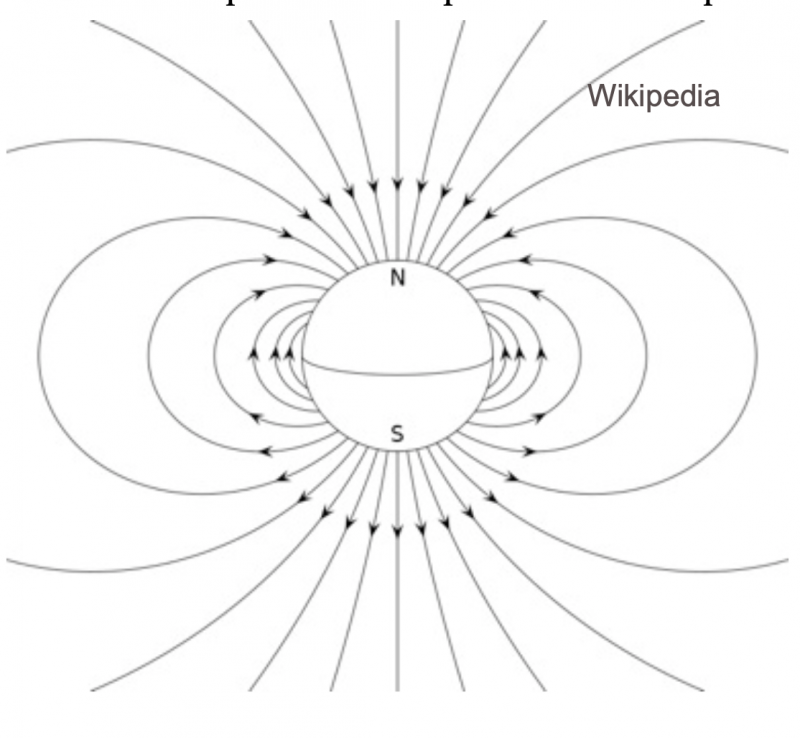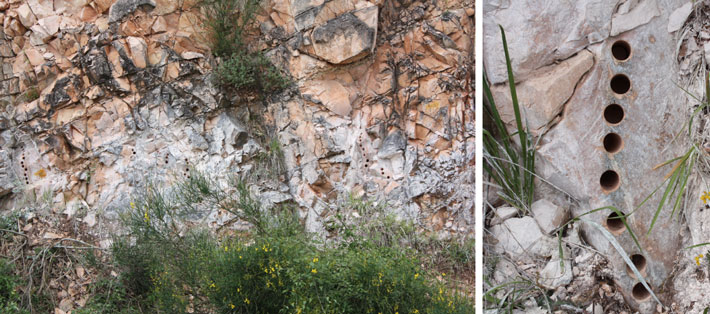
True polar wander: A major shift
The Tokyo Institute of Technology said on October 18, 2021 that one its researchers helped uncover new evidence for what’s called true polar wander. It’s the still-controversial idea that the solid outer shell of Earth might have shifted relative to Earth’s spin axis some 84 million years ago, during the late Late Cretaceous period. A statement from Tokyo Tech said:
Hold on to your hats, because scientists have found more evidence that Earth tips over from time to time. We know that the continents are moving slowly due to plate tectonics. But continental drift only pushes the tectonic plates past each other. Scientists have debated for the past few decades whether the outer, solid shell of the Earth can wobble about, or even tip over relative to the spin axis. Such a shift of Earth is called true polar wander. But the evidence for this process has been contentious. New research published in Nature Communications … provides some of the most convincing evidence to date that such planetary tipping has indeed occurred in Earth’s past.
Geologist Ross Mitchell at the Institute of Geology and Geophysics in Beijing led the new research. Joe Kirschvink of the Tokyo Tech and also Caltech was part of the research team.
A controversial idea
Kirschvink, in particular, has long specialized in measuring remanent magnetic fields in rock. These measurements can reveal the latitude at which the rock formed, millions or billions of years ago. According to a 2016 article in Science:
The technique has led [Kirschvink] to powerful, influential ideas.
[For example], in 1992, he marshaled evidence that glaciers nearly covered the globe more than 650 million years ago, and suggested that their subsequent retreat from Snowball Earth (a term he coined) triggered an evolutionary sweepstakes that would become the Cambrian explosion 540 million years ago. And he was prominent among a group of scientists who in the 1990s and 2000s argued that magnetic crystals in a famous martian meteorite, Allan Hills 84001, were fossilized signs of life on the Red Planet …
‘He’s not afraid to go out on a limb,’ says Kenneth Lohmann, a neurobiologist who studies magnetoreception in lobsters and sea turtles at the University of North Carolina, Chapel Hill. ‘He’s been right about some things and not right about other things.’

True polar wander is not this
- It’s not a geomagnetic reversal, or reversal of Earth’s magnetic field, known to have happened before in Earth history.
- It’s not plate tectonics, which describes the large-scale motions of great land plates on Earth and is thought to be driven by the circulation of Earth’s mantle.
- It’s not precession of the Earth, whereby our world’s axis of rotation slowly moves, tracing out a circle among the stars, causing the identity of our North Star changes over time.
True polar wander is this
True polar wander suggests that if an object of sufficient weight on Earth – for example, a supersized volcano or other weighty land mass – formed far from Earth’s equator, the force of Earth’s rotation would gradually pull the object away from the axis around which Earth spins. A supersized volcano far from Earth’s equator would create an imbalance, in other words. The statement from Tokyo Tech explained:
The Earth is a stratified ball. It has a solid metal inner core, a liquid metal outer core, and a solid mantle and overriding crust at the surface, which we live on. All of this is spinning like a top, once per day. Because the Earth’s outer core is liquid, the solid mantle and crust are able to slide around on top of it. Relatively dense structures, such as subducting oceanic plates and massive volcanoes like Hawaii, prefer to be near the equator. In the same way, your arms like to be out to your side when you’re spinning around in an office chair.
Joe Kirschvink was the first to propose true polar wander in 1997. And scientists do measure a small amount of true polar wander occurring today, very precisely, with satellites. But, for the past few decades, geologists have hotly debated whether large rotations of Earth’s mantle and crust occurred in Earth’s past. And a particular point of contention is whether such a large shift occurred 84 million years ago, during the Late Cretaceous. There’ve been public arguments about it in the journal Science, and at numerous science meetings, these scientists said.

Fossil magnetism tells the tale
The statement from Tokyo Tech explained:
Despite this wandering of the crust, Earth’ magnetic field is generated by electrical currents in the convecting liquid nickel-iron metal of Earth’s outer core. On long time scales, the overlying wander of the mantle and crust does not affect the core. That’s because those overlying rock layers are transparent to Earth’s magnetic field.
In contrast, the convection patterns [a roiling motion, like you see in boiling water] in this outer core are actually forced to dance around Earth’s rotation axis. That means that the overall pattern of Earth’s magnetic field is predictable, spreading out in the same fashion as iron filings lining up over a small bar magnet. So these data provide excellent information about the direction of the North and South geographic poles. And the tilt gives the distance from the poles (a vertical field means you are at the pole, horizontal tells us it was on the equator).
Many rocks actually record the direction of the local magnetic field as they form, in much the same way that a magnetic tape records your music. For example, tiny crystals of the mineral magnetite produced by some bacteria actually line up like tiny compass needles, and get trapped in the sediments when the rock solidifies. This, fossil magnetism can be used to track where the spin axis is wandering relative to the crust.
Kirschvink added:
Imagine looking at Earth from space. True polar wander would look like the Earth tipping on its side, and what’s actually happening is that the whole rocky shell of the planet—the solid mantle and crust—is rotating around the liquid outer core.

Collecting data in Italy
As a student Ross Mitchell – the lead author of the new study – studied the geology of the Apennine Mountains of central Italy. He knew just the right rocks to sample for fossil magnetism. Tokyo Tech explained:
The international team of researchers then placed their bet. They bet that paleomagnetic data from limestones created in the Cretaceous (between ~145.5 and 65.5 million years ago) located in Italy would provide a definitive test. Scientists had already studied the magnetism of the younger rocks in the same area, nearly 50 years ago. Those data had indirectly led to the discovery of the asteroid impact that killed the dinosaurs.
Sarah Slotznick, co-author and geobiologist at Dartmouth College explained:
These Italian sedimentary rocks turn out to be special and very reliable because the magnetic minerals are actually fossils of bacteria that formed chains of the mineral magnetite.
The team said in their statement:
To test [our] hypothesis about true polar wander, paleomagnetic data with lots of redundancy are required. Prior studies, especially some claiming that true polar wander does not occur, have failed to explore enough data points.
The statement quoted Richard Gordon, a geophysicist at Rice University in Houston who wasn’t involved in the study. He commented:
That is one reason why it is so refreshing to see this study with its abundant and beautiful paleomagnetic data.
A cosmic yo-yo
Ross, Kirschvink and colleagues found, as the true polar wander hypothesis predicted, the Italian data indicate an ~12-degree tilt of the planet 84 million years ago. The team also found that Earth appears to have corrected itself—after tipping on its side. It appears that Earth reversed course and rotated right back, for a total excursion of nearly 25 degrees of arc in about five million years.
These scientists said:
Certainly, this was a cosmic yo-yo.

Image via Ross Mitchell/ Tokyo Tech.
Bottom line: Researchers used the fossil magnetism of rocks in Italy to acquire a large amount of data. The data provided a record of true polar wander – a major shift in the outer shell of Earth relative to its spin axis – 84 million years ago.
Source: A Late Cretaceous true polar wander oscillation
The post True polar wander: A shift 84 million years ago first appeared on EarthSky.
from EarthSky https://ift.tt/3m9chDG

True polar wander: A major shift
The Tokyo Institute of Technology said on October 18, 2021 that one its researchers helped uncover new evidence for what’s called true polar wander. It’s the still-controversial idea that the solid outer shell of Earth might have shifted relative to Earth’s spin axis some 84 million years ago, during the late Late Cretaceous period. A statement from Tokyo Tech said:
Hold on to your hats, because scientists have found more evidence that Earth tips over from time to time. We know that the continents are moving slowly due to plate tectonics. But continental drift only pushes the tectonic plates past each other. Scientists have debated for the past few decades whether the outer, solid shell of the Earth can wobble about, or even tip over relative to the spin axis. Such a shift of Earth is called true polar wander. But the evidence for this process has been contentious. New research published in Nature Communications … provides some of the most convincing evidence to date that such planetary tipping has indeed occurred in Earth’s past.
Geologist Ross Mitchell at the Institute of Geology and Geophysics in Beijing led the new research. Joe Kirschvink of the Tokyo Tech and also Caltech was part of the research team.
A controversial idea
Kirschvink, in particular, has long specialized in measuring remanent magnetic fields in rock. These measurements can reveal the latitude at which the rock formed, millions or billions of years ago. According to a 2016 article in Science:
The technique has led [Kirschvink] to powerful, influential ideas.
[For example], in 1992, he marshaled evidence that glaciers nearly covered the globe more than 650 million years ago, and suggested that their subsequent retreat from Snowball Earth (a term he coined) triggered an evolutionary sweepstakes that would become the Cambrian explosion 540 million years ago. And he was prominent among a group of scientists who in the 1990s and 2000s argued that magnetic crystals in a famous martian meteorite, Allan Hills 84001, were fossilized signs of life on the Red Planet …
‘He’s not afraid to go out on a limb,’ says Kenneth Lohmann, a neurobiologist who studies magnetoreception in lobsters and sea turtles at the University of North Carolina, Chapel Hill. ‘He’s been right about some things and not right about other things.’

True polar wander is not this
- It’s not a geomagnetic reversal, or reversal of Earth’s magnetic field, known to have happened before in Earth history.
- It’s not plate tectonics, which describes the large-scale motions of great land plates on Earth and is thought to be driven by the circulation of Earth’s mantle.
- It’s not precession of the Earth, whereby our world’s axis of rotation slowly moves, tracing out a circle among the stars, causing the identity of our North Star changes over time.
True polar wander is this
True polar wander suggests that if an object of sufficient weight on Earth – for example, a supersized volcano or other weighty land mass – formed far from Earth’s equator, the force of Earth’s rotation would gradually pull the object away from the axis around which Earth spins. A supersized volcano far from Earth’s equator would create an imbalance, in other words. The statement from Tokyo Tech explained:
The Earth is a stratified ball. It has a solid metal inner core, a liquid metal outer core, and a solid mantle and overriding crust at the surface, which we live on. All of this is spinning like a top, once per day. Because the Earth’s outer core is liquid, the solid mantle and crust are able to slide around on top of it. Relatively dense structures, such as subducting oceanic plates and massive volcanoes like Hawaii, prefer to be near the equator. In the same way, your arms like to be out to your side when you’re spinning around in an office chair.
Joe Kirschvink was the first to propose true polar wander in 1997. And scientists do measure a small amount of true polar wander occurring today, very precisely, with satellites. But, for the past few decades, geologists have hotly debated whether large rotations of Earth’s mantle and crust occurred in Earth’s past. And a particular point of contention is whether such a large shift occurred 84 million years ago, during the Late Cretaceous. There’ve been public arguments about it in the journal Science, and at numerous science meetings, these scientists said.

Fossil magnetism tells the tale
The statement from Tokyo Tech explained:
Despite this wandering of the crust, Earth’ magnetic field is generated by electrical currents in the convecting liquid nickel-iron metal of Earth’s outer core. On long time scales, the overlying wander of the mantle and crust does not affect the core. That’s because those overlying rock layers are transparent to Earth’s magnetic field.
In contrast, the convection patterns [a roiling motion, like you see in boiling water] in this outer core are actually forced to dance around Earth’s rotation axis. That means that the overall pattern of Earth’s magnetic field is predictable, spreading out in the same fashion as iron filings lining up over a small bar magnet. So these data provide excellent information about the direction of the North and South geographic poles. And the tilt gives the distance from the poles (a vertical field means you are at the pole, horizontal tells us it was on the equator).
Many rocks actually record the direction of the local magnetic field as they form, in much the same way that a magnetic tape records your music. For example, tiny crystals of the mineral magnetite produced by some bacteria actually line up like tiny compass needles, and get trapped in the sediments when the rock solidifies. This, fossil magnetism can be used to track where the spin axis is wandering relative to the crust.
Kirschvink added:
Imagine looking at Earth from space. True polar wander would look like the Earth tipping on its side, and what’s actually happening is that the whole rocky shell of the planet—the solid mantle and crust—is rotating around the liquid outer core.

Collecting data in Italy
As a student Ross Mitchell – the lead author of the new study – studied the geology of the Apennine Mountains of central Italy. He knew just the right rocks to sample for fossil magnetism. Tokyo Tech explained:
The international team of researchers then placed their bet. They bet that paleomagnetic data from limestones created in the Cretaceous (between ~145.5 and 65.5 million years ago) located in Italy would provide a definitive test. Scientists had already studied the magnetism of the younger rocks in the same area, nearly 50 years ago. Those data had indirectly led to the discovery of the asteroid impact that killed the dinosaurs.
Sarah Slotznick, co-author and geobiologist at Dartmouth College explained:
These Italian sedimentary rocks turn out to be special and very reliable because the magnetic minerals are actually fossils of bacteria that formed chains of the mineral magnetite.
The team said in their statement:
To test [our] hypothesis about true polar wander, paleomagnetic data with lots of redundancy are required. Prior studies, especially some claiming that true polar wander does not occur, have failed to explore enough data points.
The statement quoted Richard Gordon, a geophysicist at Rice University in Houston who wasn’t involved in the study. He commented:
That is one reason why it is so refreshing to see this study with its abundant and beautiful paleomagnetic data.
A cosmic yo-yo
Ross, Kirschvink and colleagues found, as the true polar wander hypothesis predicted, the Italian data indicate an ~12-degree tilt of the planet 84 million years ago. The team also found that Earth appears to have corrected itself—after tipping on its side. It appears that Earth reversed course and rotated right back, for a total excursion of nearly 25 degrees of arc in about five million years.
These scientists said:
Certainly, this was a cosmic yo-yo.

Image via Ross Mitchell/ Tokyo Tech.
Bottom line: Researchers used the fossil magnetism of rocks in Italy to acquire a large amount of data. The data provided a record of true polar wander – a major shift in the outer shell of Earth relative to its spin axis – 84 million years ago.
Source: A Late Cretaceous true polar wander oscillation
The post True polar wander: A shift 84 million years ago first appeared on EarthSky.
from EarthSky https://ift.tt/3m9chDG

Aucun commentaire:
Enregistrer un commentaire